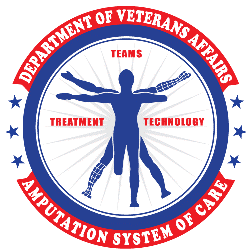Rehabilitation and Prosthetic Services
Amputation System of Care (ASoC)

Historical Outlook - ASoC
For more than 150 years, the Department of Veterans Affairs (VA) has held the care provided to Veterans with limb amputations as a high priority. To many Americans, the Veteran with an amputation epitomizes the sacrifices made on our nation’s behalf. The VA is dedicated toproviding optimal care for these individuals in order to restore function and improve quality of life.
This commitment has been reaffirmed over time through the passage of key legislation such as the Veterans Medical Programs Amendments of 1992 (Public Law 102-405) identifying the Veterans with amputations as a special disability group and emphasized the importance for VHA to provide the highest quality of care to this patient population. The Federal Advisory Committee on Prosthetics and Special Disabilities Programs was also chartered to review VA’s programs responsible for amputation prevention and the rehabilitation and prosthetic care of those with amputations. The Veterans’ Health Care Eligibility Act of 1996, (Public Law 104-262), Section 104 required VA to maintain its capacity to care for the needs of patients with amputations, consistent with the level at the time of passage of the legislation. As a result of the enactment of these laws and the formation of the Federal Advisory Committee on Prosthetics and Special Disability Programs, VA has developed an extensive program for amputation rehabilitation.
In 2008, after years of planning and preparation, VA approved and began implementing the Amputation System of Care (ASoC) in order to enhance the quality and consistency of care provided to the Veteran with limb loss. The driving force behind this program was the need to provide lifelong care for service members with combat-related amputations from the military conflicts in Iraq and Afghanistan and for Veterans with amputations from diseases such as diabetes and peripheral vascular disease. The system is designed to provide the latest practices in medical care, prosthetic technology, and rehabilitation management in order to assist individuals with amputations in reaching their highest level of functional independence.
The majority of Veterans with amputations treated within VHA remain those resulting from diabetes or peripheral vascular disease (PVD). This type of amputation generally occurs in the aging Veteran and is associated with numerous comorbidities such as cardiovascular disease, hypertension, end-stage renal disease with dialysis, and arthritis. However, the number of Veterans with traumatic amputation due to combat is increasing. The Global War on Terror (GWOT), Operation Enduring Freedom (OEF), and Operation Iraqi Freedom (OIF) have introduced a new generation of Veterans into VA’s healthcare system. This group tends to be young and desire to return to a full, active lifestyle that demands VA develop a consistent approach in providing these Veterans the latest in treatment, technology, and rehabilitation techniques. Although the number of these combat related amputations is relatively small compared with those associated with disease, both groups have equal needs for quality programs, comprehensive services, and life-long care. To meet these needs VA has enhanced the current system of care moving from a disease model to a wellness model and assuring equal access for all Veterans.



















